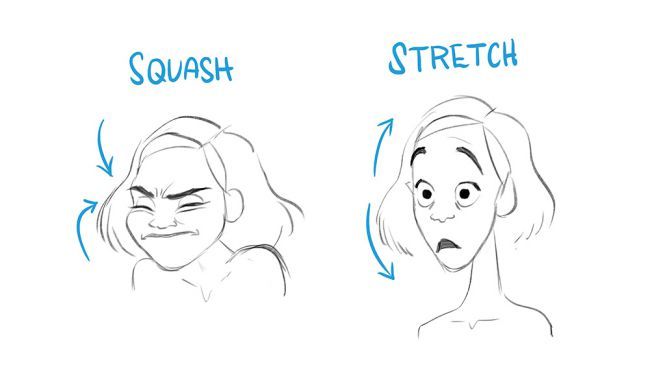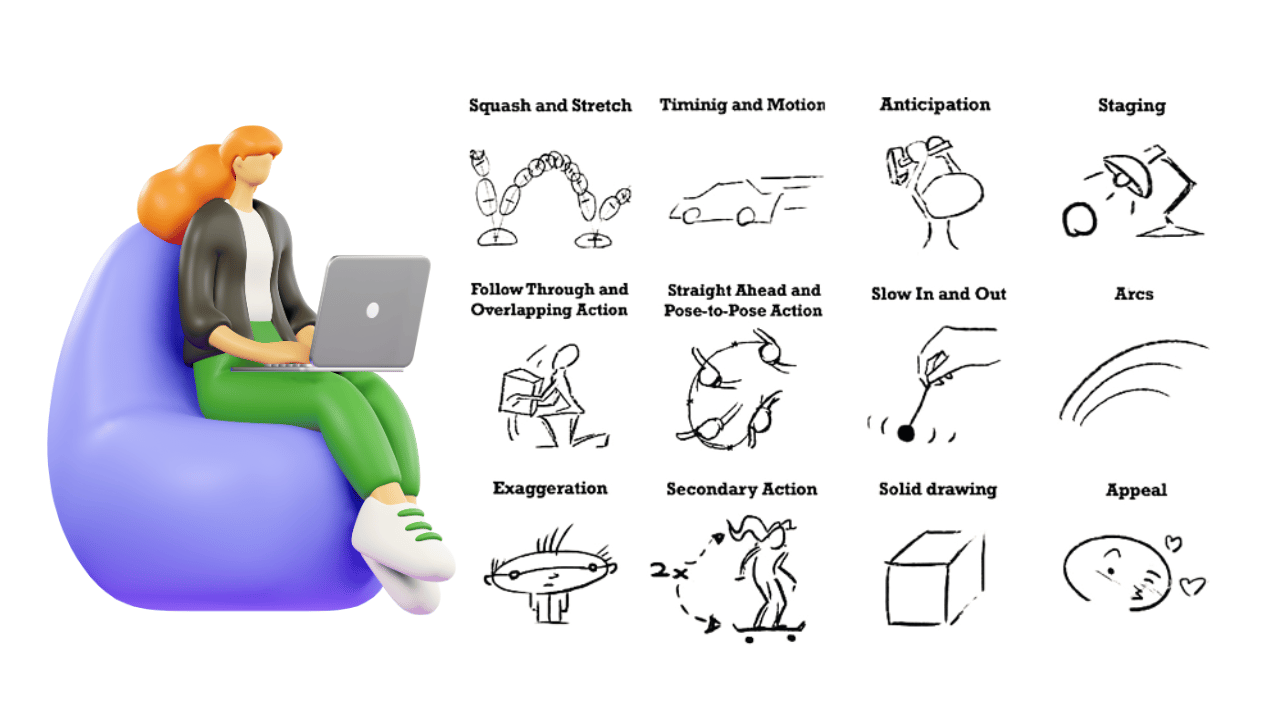Welcome to the magical realm of animation, where skilled animators weave their artistry to breathe life into characters and stories. Get ready to unlock the secrets behind the mesmerizing world of animation with the 7 Principles – the essential tools that make animated creations come alive. From the graceful movements of Arcs to the dynamic interplay of Anticipation, we’ll demystify these principles using real-world examples from animation giants like Disney, Pixar, DreamWorks, and Studio Ghibli.
Join us on a journey where we break down the complexities into simple, captivating insights. From Straight Forward Action to the delightful Stretch and Squash, we’ll guide you through each principle with clarity and excitement. Discover the enchanting techniques that bring your favorite animated characters to life, and explore how these principles are the heartbeat of the animation industry.
7 Principles of Animation

Squash and Stretch
Squash and Stretch is 1st of 7 principles of animation and the fundamental principle of animation described as squash and stretch emphasizes the adaptability and elasticity of animated objects. This approach is used to give characters and things a sense of weight, volume, and motion. Animators can produce a more convincing appearance of life by changing an object’s shape while it is in motion.
Understanding Squash and Stretch
A fascinating ballet of irregularity and flexibility occurs when external forces come into contact with an object. Picture a colorful, bouncing ball speeding into the harsh ground. The ball experiences a stunning metamorphosis upon collision, briefly yielding to the tremendous energy. As though embracing the earth with a short closeness, it contracts in response to the pressure. A fascinating change, though, occurs as the ball bounces. It extends, stretching every strand of its body, striving for the skies with a firm resolve. It reverts to its previous shape, propelled by an unseen energy, defying gravity’s grip.
The squash and stretch concept, which governs the physicality of objects, also applies to character animation. Exaggerated face expressions of cartoon characters come to life within the bright tapestry of animation environments, their features squashing and stretching in cycle with their emotions. And when characters go through their animated adventures, their bodies flex and deform, bending and twisting with each beautiful step. This is one of 7 Principles of Animation that infusing their works with an appealing vibrancy and an unmistakable spark of realism, animators give their works life through this delicate balancing act of irregularity and reformation.
Real-World Examples
Tom & Jerry
In the evergreen realm of Tom and Jerry cartoons, the creativity of squash and stretch techniques rules supreme, resulting in a parade of exaggerated and funny movements. Tom, the crafty cat, pursues Jerry, the crafty mouse, relentlessly, and their exchanges take place in an energetic frenzy of pliable forms. With each unexpected turn and twist, the figures distort and deform, their bodies elongating and shrinking like elastic, causing audiences of all ages to laugh and smile. The fundamentals of animation come to life with each bounce upon collision and each bounce as they rebound, giving the cartoon an unmistakable feeling of playfulness and kinetic energy.
Disney’s Aladdin
Meet the magical land of Disney’s Aladdin, where the Genie commands attention as a master of amazing shape-shifting feats. With the flick of his magical wrist, he changes into a variety of shapes, smoothly changing from a massive figure to a tiny person. Every amazing change he performs demonstrates the artistry of squash and stretch as he navigates the limits of truth and fantasy. The Genie’s flexible body gently expands and contracts, gracefully and precisely adjusting to every quirky change. The use of squash and stretch gives life to this animated wonder, allowing the Genie to move through the worlds of dream with an unsurpassed feeling of fluidity, whether he extends his limbs to incredible lengths or compresses himself into a compacted ball of energy.

Anticipation
A key concept that gets the audience ready for an upcoming action or event is anticipation. Anticipation helps make the animation more believable and interesting by giving visual hints before a key action takes place.
Understanding Anticipation
Anticipation weaves its glamorous threads through the tapestry of animation, like an orchestral masterwork approaching its climatic apex. This is the second of 7 Principles of Animation. Before the spectacular launch of a gripping action, actors, and objects participate in a mesmerizing introduction, tantalizing the audience’s senses. Imagine a character about to leap, their muscles tensing, and their body coiling like a tightly wound spring. As the figure gets into a crouching position, accumulating energy, and setting for an exciting moment, the audience watches with anticipation. The magic happens during these priceless intervals of eager expectancy.
Animation embraces the art of anticipation in countless forms. As a baseball pitcher gears up for a mighty throw, a mesmerizing choreography begins. The wind-up becomes a symphony of movements, a visual overture, foreshadowing the explosive release of the ball. Through subtle gestures, lingering glances, or carefully timed actions, animators harness the power of anticipation, painting the canvas of animation with hints of what is yet to come. It is within these fleeting moments that the audience is invited to share in the anticipation, their senses sharp, their hearts racing, eagerly awaiting the unfolding spectacle that lies just around the corner.
Real-World Examples
The Lion King
As the majestic Savannah stretches beneath the golden African sun, an iconic moment unfolds in Disney’s The Lion King. Simba, the young lion prince, stands self-confident at the edge of a cliff, his gaze fixed upon his ultimate destination—Pride Rock. In a display of anticipation that sends ripples of excitement through the audience’s hearts, Simba crouches low, muscles tensing, preparing for the monumental leap that will mark his triumphant return. Every subtle movement, from the twitch of his tail to the focused intensity in his eyes, serves as a testament to his determination and the anticipation that lingers in the air. The weight of the world rests on Simba’s shoulders, and in this fleeting moment, the power of anticipation is harnessed, heightening the emotional resonance and setting the stage for a breathtaking climax.
Pixar’s Toy Story
In the enchanting world of Pixar’s Toy Story, Woody, the loyal cowboy toy, finds himself in yet another daring escapade. Perched atop a window sill, he gazes out into the vast unknown, his plastic body trembling with a mix of excitement and trepidation. In a captivating display of anticipation, Woody winds up the string in his back, coiling it tightly, readying himself for the daring swing that will propel him towards the moving truck. Each subtle twist and turn of the wind-up mechanism mirror the building tension and anticipation that vibrates through Woody’s small frame. The room is imbued with a physical energy as time slows down, and with a final release, Woody is launched into the unknown. This fleeting moment of anticipation captures the essence of adventure, igniting a sense of wonder and propelling the audience into a thrilling journey alongside their beloved toy companion.

Staging
Staging is the principle that focuses on presenting an idea or action clearly and concisely. This can be achieved through various methods, including composition, camera angles, lighting, and character positioning.
Understanding Staging
Staging stands out as a brilliant orchestrator within the broad spectrum of 7 Principles of Animation, expertly directing the audience’s attention to the core of the story. It has the ability to create the visual environment to most effectively and dramatically deliver the intended message. Staging skillfully orchestrates the symphony of animated elements, assuring harmony and tone like an accomplished conductor.
Consider a crucial interaction in a conversation that is rife with unsaid feelings. Here, staging serves as the viewer’s lens, allowing them to see the hidden depths and hues. The characters’ essence is best captured in a close-up shot, with their faces frozen in unadulterated vulnerability and their words flowing with hidden truths. The sheer intensity of the relationship overshadows everything else, blending into the background. The audience is pushed into an intimate space by the visual isolation, where each phrase and each action has a profound meaning.
The narrative canvas is shaped by staging with its variety of composition, camera angles, lighting, and character positioning. It shapes the experience of the viewer, enabling the intended message to assume the spotlight and enthralling hearts and minds. With its deft touches, staging gives life to the scene’s most important components, revealing a fascinating exhibition that resonates emotionally with its audience.
Real-World Examples
DreamWorks’ Shrek
A moving scene from the DreamWorks film Shrek plays out in the glittering moonlight. A symphony of dancing fireflies surrounds Shrek and Donkey, an unusual pair on an enthralling journey, as they are wrapped in a tranquil clearing. The moon casts a gentle, ethereal light that highlights their shapes in this expertly created image. The focus tightens as the camera smoothly sweeps around, luring us into the private conversation between these two unique personalities. Each delicate movement and nuanced expression is skillfully framed, bringing out the intensity of their emotional bond. Their sincere dialogue reverberates against a starry sky and the rustling of leaves, brought to life by the compelling staging that enables us to see how their souls are interwoven beneath the moonlit tapestry.
Disney’s Beauty and the Beast
Prepare to be enchanted as Disney’s Beauty and the Beast unfolds its grand tapestry of romance and wonder. In the opulent ballroom scene, all elements of staging align to create a mesmerizing spectacle. The grandeur of the setting unfolds before our eyes, with majestic chandeliers casting a cascading brilliance upon the lavishly adorned walls. The camera gracefully glides through the air, capturing the splendor of the moment. As Belle, resplendent in her golden gown, steps into the arms of the Beast, the staging further amplifies the enchantment. The sweeping dance floor, bathed in soft candlelight, seems to expand infinitely, creating an otherworldly ambiance. Every twirl and dip are meticulously choreographed, emphasizing the profound connection between the two characters. Through the carefully staged ballroom dance, we are transported into a world where beauty transcends appearances, and love unfolds amidst a symphony of opulence and grace.

Straight Ahead Action and Pose to Pose
Straight ahead action and pose to pose are two distinct approaches to animating a sequence. In straight ahead action, the animator works sequentially, creating each frame one after another. In contrast, the pose-to-pose method involves planning and drawing key poses first, then filling in the in-between frames.
Understanding Straight Ahead Action and Pose to Pose
In the realm of 7 Principles of Animation, two distinct paths unfold, each offering its own attraction and challenges. Enter the realm of straight-ahead action, a dance of improvisation and artistic freedom. Like an artist’s brushstrokes on a blank canvas, each frame is delicately crafted in a spontaneous symphony. Here, animators embark on a journey of discovery, embracing the exciting unknown, as their creation unfolds before their very eyes. The result is an organic tapestry, packed with life, a testament to the sheer vitality of the artistic process.
Yet, in the depths of the animation realm, another path summons—the path of pose-to-pose. Here, thorough planning and deliberate strokes reign supreme. Animators wield their vision with precision, laying down the key poses that will shape the animation’s core. With a calculated approach, they navigate the complicated landscape of timing and structure, leaving no detail untouched. The outcome is a composition of control, a masterpiece crafted with meticulous care and attention to detail.
However, like two sides of a coin, both paths bear their unique trade-offs. Straight ahead action abandons control over the final outcome, while pose-to-pose sacrifices some of the organic variability that arises from spontaneous creation. Yet, within this duality lies the key to captivating animation. Skillful animators intertwine these approaches, harmonizing freedom with structure, unlocking a realm of dynamic and engaging animations. It is the fusion of these paths that births animations that breathe, animations that resonate with the beating heart of the artistic spirit.
Real-World Examples
Hand-drawn animation
Explore the realm of traditional hand-drawn animation, where talented creators use a charming combination of methods to bring pencil strokes to life. Straightforward action and pose to pose are two different ways that play out in this space in a delicate dance. Every time an animator makes a hand motion, the magic of movement is revealed. The straight-ahead action style, where each frame is painstakingly drawn in a sequential flow, gives the animation life, captures the essence of spontaneity and fluidity. The characters are given a vibrant energy by the lines, which appear to dance and come to life. Pose to posture, meanwhile, exudes a sense of precision and control. Key positions are meticulously planned and captured by the animator, who adds intention and passion to each one. The animator can build the structure of the animation using these poses as a guide, and the in-between frames fill in the spaces like connective tissue does when knitting motion together. Animation masterworks that stand the test of time are produced as the two disciplines converge.
Modern Computer-Generated Animation
Explore the amazing world of contemporary computer-generated animation, where pixels and algorithms combine to tell enthralling stories. The pose-to-pose method, a cornerstone of the digital world, is used in this instance to accelerate the artistry of animation. In this area, animators make use of technology, creating spectacular sequences by using key frame animation and interpolation. A virtual world comes to life with each stroke of the electronic pen. Key postures are painstakingly crafted by animators, defining the core essence of the characters and their story. The time and emotional beats are determined by these essential positions, which serve as the foundation of the animation. The computer then generates in-between frames in a smooth and precise manner, interpolating and filling the spaces between positions with its digital magic.

Follow Through and Overlapping Action
Animations become more realistic and fluid by adhering to the follow through and overlapping action rules. When the main action has been finished, movement is said to be “follow through,” as opposed to “overlapping action,” which happens when various sections of an object or character move at various rates or intervals.
Understanding Follow Through and Overlapping Action
The combination of follow through and overlapping action in animation lends a delicate touch of magic and this is the best one in 7 Principles of Animation. These principles give the animated world life and a captivating feeling of reality, like the lingering echoes of a symphony. Animators create animations that dance authentically and engage the senses through their meticulous execution.
Have you seen a person releasing a ball by gracefully arching their arm. A mesmerizing occurrence occurs as the ball soars through the air—the arm continues to shake in time with the beat, a subtle follow-through that lends an additional level of authenticity. The animation goes beyond simple movement by embracing the results of one’s actions and revealing a world full of fine distinctions.
But the enchantment does not cease there. Observe the character in repose, their hair cascading and clothing billowing in the wind. Though the character may come to a still, a gentle dance of overlapping action persists. The hair sways, each strand filled with a mesmerizing fluidity. The clothing breathes, gently fluttering in an unearthly choreography. These lingering motions weave a vivid tapestry of realism, mirroring the short-lived nature of existence itself.
Through the symphony of follow through and overlapping action, animators compose animations that transcend the boundaries of mere imagery. They paint a world alive with the echoes of movement, where every action reverberates, and every detail shimmers with authenticity. It is within this interplay that the animated realm becomes a mirror of life, a testament to the magic of the animator’s craft.
Real-World Examples
Disney’s Moana
The Animated World of Disney’s Moana, where the very essence of movement takes on a breathtaking form. As the courageous Moana sails across the vast ocean, her flowing locks of hair sway and dance in perfect harmony with the whimsical breeze. All strand cascades and ripples with a mesmerizing fluidity, capturing the essence of follow through and overlapping action. Like a fascinating melody, each movement carries a trace of the previous, creating a captivating symphony of motion. Simultaneously, the mighty ocean waves rise and fall, cresting with an irresistible allure. As they crash and surge with unrivaled power, their motion lingers beyond the moment, overlapping and cascading in harmonious resonance. Through the meticulous attention to detail, the animators breathe life into these elements, infusing them with a naturalistic beauty that enchants and captivates.
The Iron Giant
In Warner Bros.’ The Iron Giant, where the clanking gears and colossal machinery intertwine to create a spellbinding spectacle. Towering above all, the Iron Giant, a mechanical marvel, strides forward with an imposing presence. With every calculated movement, the various components of his formidable structure display a mesmerizing display of overlapping action. As his colossal limbs extend and retract, the metallic joints interlock and flow in a synchronized ballet, conveying a sense of immense weight and realism. The gears and pistons churn with meticulous precision, their motions overlapping and cascading with a hypnotic grace. It is through this delicate choreography of mechanical parts that the animators masterfully evoke a powerful sense of authenticity and believability, breathing life into the awe-inspiring creation known as the Iron Giant.

Slow In and Slow Out
Slow in and slow out is a principle that emphasizes the natural acceleration and deceleration of objects in motion. By gradually increasing and decreasing the speed of an action, animators can create more realistic and appealing animations.
Understanding Slow In and Slow Out
The world of animation unfolds with a captivating rhythm, guided by the principle of slow in and slow out. As objects and characters awaken from stillness, characterized by a delicate interplay of acceleration and deceleration.
Imagine a character taking its first step, a gradual development of motion that reveals a symphony of elegance. The movement begins with a gentle slowness, each frame accurately crafted to depict the transition from rest to action. As momentum builds, the pace quickens, infusing the animation with vibrant energy, mirroring the dynamics of force and velocity in the real world.
Yet, as the dance draws to a close, a subtle deceleration follows, guiding the character into a gentle repose. Each frame becomes a testament to the animator’s artistry, carefully composing the gradual reduction of motion.
By skillfully incorporating slow in and slow out, animators give their creations with a deep sense of weight and presence. The measured tempo of acceleration and deceleration breathes life into the animation, infusing it with a compelling realism and fluidity. Within this rhythmic embrace of motion, the animated realm truly comes alive, capturing the essence of movement in all its complicated beauty.
Real-World Examples
Disney’s Tarzan
Step into the lush and vibrant world of Disney’s Tarzan, where the air crackles with excitement and the lush foliage of the jungle beckons. As the fearless Tarzan swings effortlessly from vine to vine, the principles of slow in and slow out come to life with mesmerizing grace. With each powerful leap, his movement begins with a deliberate and gradual acceleration, building anticipation and setting the stage for the exhilarating journey ahead. As he reaches the apex of his swing, time seems to stand still, allowing the audience to savor the sheer freedom and weightlessness of the moment. And then, with a gentle deceleration, Tarzan gracefully lands on the next vine, the energy of the swing dissipating in a seamless transition. This careful attention to the principles of slow in and slow out infuses the scene with a palpable sense of weight, momentum, and organic fluidity, inviting viewers to join Tarzan on his thrilling aerial escapades.
How to Train Your Dragon
DreamWorks’ How to Train Your Dragon, where majestic dragons soar through the skies with an awe-inspiring grace. As these mythical creatures take to the air, their flight sequences exemplify the delicate mastery of the slow in and slow out principle. With each beat of their powerful wings, the dragons begin their ascent with a deliberate and gradual acceleration, the force of their motion propelling them higher into the boundless sky. As they reach their cruising speed, the rhythm of their wings becomes a mesmerizing ballet, their movement flowing with a sense of weight and purpose. And as they prepare for a graceful descent, the dragons gradually decelerate, their flight becoming gentler and more controlled. This careful application of slow in and slow out imbues the flight sequences with a profound sense of realism, capturing the essence of the dragons’ strength, weight, and majestic presence in the skies above.

Arcs
Arcs are a principle that highlights the curved paths of objects and characters in motion. By following arcs, animators can create smoother and more natural-looking animations.
Understanding Arcs
In the realm of reality, the interplay of gravity and biomechanics gives rise to a captivating choreography of arcs, dictating the movements we witness in our everyday lives. From the gentle swing of a pendulum to the graceful sweep of a character’s arm tracing a circular path, arcs hold the key to unlocking the essence of motion.
Imagine the mesmerizing sway of a pendulum, gracefully carving its path through the air. Each arc it traces reflects the melodious balance between the gravitational force and the pendulum’s characteristic properties. This hypnotic motion captures our attention, immersing us in the continuous symphony of natural dynamics.
In the realm of animation, the power of arcs is harnessed to exceed the boundaries of reality. By embracing this principle, animators fill their creations with a heightened sense of believability and aesthetic appeal. Whether it’s the enchanting wand movements of a fairy godmother or the otherworldly flight trajectory of a majestic dragon, arcs imbue animations with a mesmerizing fluidity that enthralls audiences and transports them to extraordinary realms.
Through the mastery of arcs, animators breathe life into their creations, bridging the realms of imagination and reality. The artful implementation of arcs invites viewers to embark on a journey where the extraordinary becomes tangible, and the familiar becomes extraordinary. Within the realm of animation, arcs reign supreme, weaving a tapestry of motion that captivates the senses and reveals the limitless possibilities of the animated world.
Real-World Examples
Disney’s Cinderella
Dreams come true and magic permeates the atmosphere in Cinderella, a Disney film. The Fairy Godmother flicks her wand in the famous transformation scene, casting a spell that brings a glittering metamorphosis to life. The wand follows a perfectly curved path as her hand gently makes an arc through the air, tracing the path of the magic it summons. The movement is a visual symphony of elegance and precision, and the arc gives the shift a sense of fluidity and grace. Every wave of the Fairy Godmother’s wand leaves behind a spellbinding trail that captures our attention and carries us away to a place where wishes are granted and fairy tales come to life.
Spirited Away
Spirited Away by Studio Ghibli is an example of how the extraordinary and commonplace may coexist. Haku, the mysterious river spirit in the shape of a dragon, soars across the celestial skies in a beguiling show of ethereal splendor. His motions, which are dictated by the arcs principle as he soars softly above, each wingbeat forming a mellow curve across the air. His flight path’s arc mimics the sky’s natural shapes, resulting in a flawless dance between the environment and the creature. Haku’s motion exudes a magnificent harmony with each glide and turn, inspiring awe and serenity.
Conclusion:
Thank you for persevering through this lengthy guide. I admire your commitment to learning about the 7 principles of animation. Your recommendations will be considered to make sure that this manual is constantly upgraded.
The 7 principles of animation give animated works of art its vitality and realism, while also captivating audiences. As anticipation increases involvement, squash and stretch transmit weight and flexibility. Straightforward motion and pose to pose balance spontaneity and control, while staging ensures clarity and composition. Follow through and overlapping action provide realism, while slow in and slow out represent natural acceleration and deceleration. Smooth, organic movements are produced by arcs. These ideas are clearly demonstrated in real-world situations, from Tom and Jerry to The Lion King. By understanding these concepts, animators give their work life, engaging viewers and influencing future generations in the dynamic field of animation.





